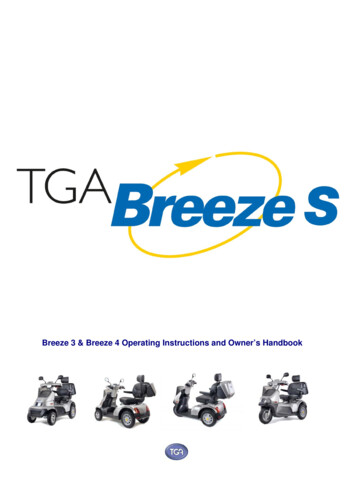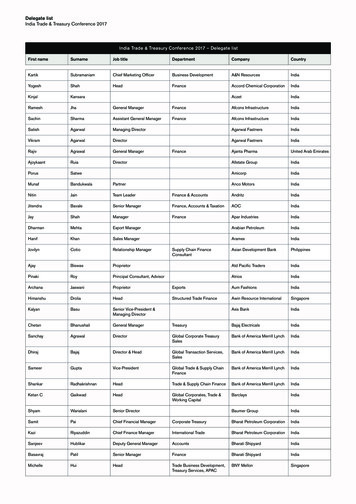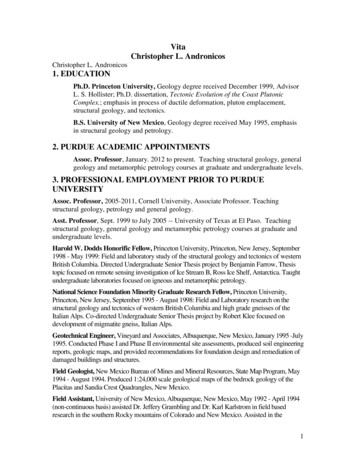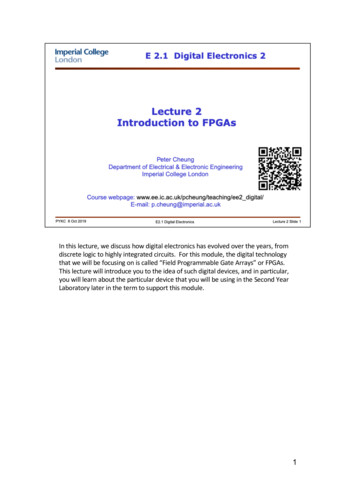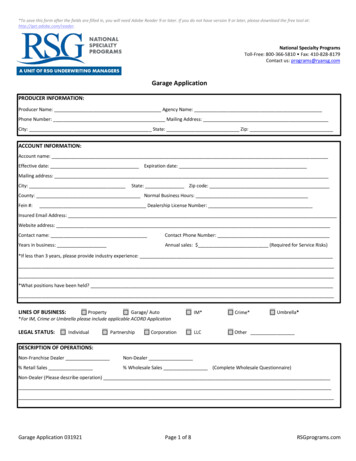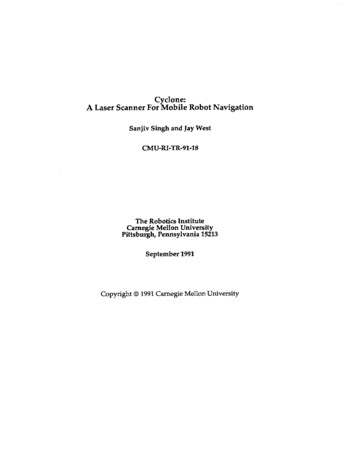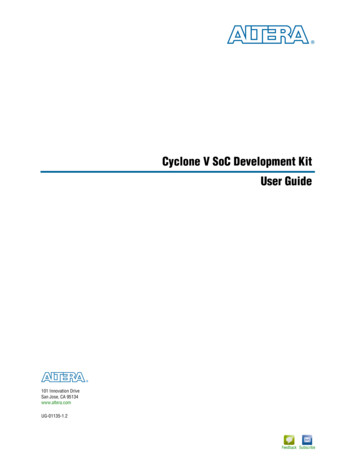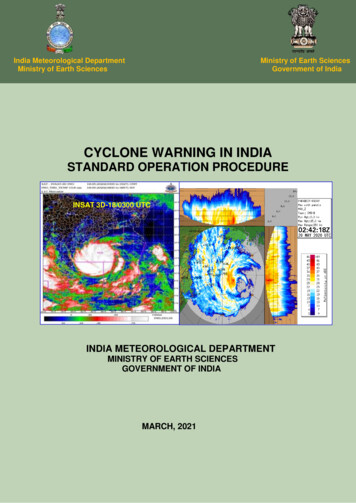
Transcription
India Meteorological DepartmentMinistry of Earth SciencesMinistry of Earth SciencesGovernment of IndiaCYCLONE WARNING IN INDIASTANDARD OPERATION PROCEDUREINSAT 3D-18/0300 UTCINDIA METEOROLOGICAL DEPARTMENTMINISTRY OF EARTH SCIENCESGOVERNMENT OF INDIAMARCH, 2021
PREFACEA tropical cyclone (TC) is a multihazard weather phenomenon, as it leads toheavy rainfall, gale wind and storm surge during the landfall. It also effects severelythe marine activities during its life over the Sea. Though fewer tropical cyclones(about 7 % of global frequency) occur over the north Indian Ocean (NIO), it causesheavy loss of life and property over the region.Various components of early warning system for TCs include (i) hazardanalysis, (ii) monitoring (iii) modeling, (iv) forecasting, (v) impact & risk assessment,(vi) warning generation, presentation & dissemination, (vii) co-ordination withdisaster management agencies, (viii) public education & reaching out and (ix) postevent review. Over the years, the India Meteorological Department (IMD) has built upa credible Cyclone Warning System for the country which utilises augmentedobservational network, satellites, radars, array of various global & regional numericalweather prediction (NWP) models and modern information and communicationtechnology for analysis, forecasting and warning generation & dissemination. In theevent of an approaching TC, IMD issues impact based warnings to all concernedincluding the government, the local population, media and stakeholders through avariety of communication channels. As a result, during recent years the loss of lifedue to TCs has been reduced significantly to less than 100 in any cyclone. However,the huge loss of property due to TCs is still a challenge to be addressed.All the aspects of the early warning system of TCs have been standardized inthe document “Standard Operational Procedure (SOP) for Cyclone Warning in India”to improve the efficiency of cyclone warning system. As there have been significantimprovements in all the components of cyclone warning system during recent yearsincluding observations, modeling and communication, the Cyclone Warning Divisionof IMD has updated this document incorporating all the latest developments in thefield. This SOP document will be useful to forecasters, early warning serviceproviders and disaster management agencies in effectively mitigating disaster due toTCs.Mrutyunjay MohapatraMarch 2021Director General of Meteorology
AcknowledgementsI am thankful to all the Officers and Staff members of Cyclone WarningDivision for their coordinated efforts that went into the formulation of the Manualentitled “Cyclone Warning in India-Standard Operation Procedure”.I hereby place on record my deep appreciation for the valuable contributionsmade by Mrs. Sunitha Devi, Scientist-F & Head Cyclone Warning Division and Mrs.Monica Sharma, Scientist-D, Cyclone Warning Division towards preparation,compilation, edition, review and publication of this manual. I express my sincerethanks and appreciation to Mr. Mukesh Kumar, SA, Mr. Santosh Singh, SA Mr.Gaurav Kumar Srivastav, SA, Mr. Aditya Chaudhary, SA, Ms. Shilpa Singh, SA andMr. V. Vijay Kumar, Meteorologist B for their technical support in publication of thisdocument.Mrutyunjay MohapatraMarch 2021Director General of Meteorology
CONTENTSI.Introduction1-56II.Cyclone Warning Organisation57-63III.Needs for monitoring and prediction64-70IV.Observational aspects of cyclone warning system71-100V.Monitoring and Prediction technique101-143VI.Bulletins and warnings144-195VII.Cyclone Warning Dissemination196-197VIII.Pre-cyclone Exercise198-202IX.Post Cyclone Action203-216X.Management of Cyclone and Common Man217-219XI.Conclusions and future scope220
List of AcronymsACWCArea Cyclone Warning CentreADTAdvanced Dvorak TechniqueAIRAll India RadioAMSSAutomatic Message Switching SystemAMSUAdvanced Microwave Sounder UnitARBArabian SeaARG’sAutomatic Rain Gauge StationsAWSAutomatic Weather StationBoBBay of BengalBoMBureau of MeteorologyC.I. No.Current Intensity NumberCAPEConvective Available Potential EnergyCCDCharge Coupled DeviceCDMCCyclone Distress Mitigation CommitteeCDOCentral Dense OvercastCDRCyclone Detection RADARCDsCyclonic DisturbancesCIMSSCooperative Institute for Meteorological Satellite StudiesCINEConvective Inhibition EnergyCIPSCooperative Institute for Precipitation SystemsCLIPER ModelClimatology and Persistence ModelCMVCloud Motion VectorsCOUCone of UncertaintyCPCClimate Prediction CentreCRCCyclone Review CommitteeCTTCloud Top TemperatureCWCCyclone Warning CentreCWDCyclone Warning DivisionCWRCCyclone Warning Research CentreDMDDDigital Meteorological Data DisseminationDMSPDefence Met. Satellite Programme of U.S.A.DPEDirect Position ErrorDRMSDistrict-wise Rainfall Monitoring Scheme
DWRDoppler Weather RADARECMWFEuropean Centre for Medium-Range Weather ForecastsEEC RadarsEnterprise Electronics Corporation RadarsEIREnhanced InfraredEPSEnsemble Prediction SystemFNMOCFleet Numerical Meteorology and Oceanography CentreGEFSGlobal Ensemble Forecast SystemGFSGlobal Forecast SystemGMDSSGlobal Maritime Distress Safety SystemGPPGenesis Potential ParameterGTSGlobal Telecommunication SystemHFRTHigh Frequency Radio TransmissionHSDTHigh Speed Data TerminalsHWRFHurricane Weather Research and ForecastingIADPIntensive Agricultural Development ProgrammeIAFIndian Air ForceICAOInternational Civil Aviation OrganisationIITDIndian Institute of Technology DelhiIMDIndia Meteorological DepartmentIMDPSIndian Meteorological Data Processing SystemINCOISIndian National Centre for Ocean Information ServicesINOSHACIndian Ocean & South Hemispheric CentreINSATIndian National Satellite SystemIOPIntense Observation PeriodIRInfrared RedISTIndia Standard TimeITCZInter-Tropical Convergence ZoneIVRSInteractive Voice Response SystemJMAJapan Meteorological AgencyJTWCJoint Typhoon Warning CenterLESLocal Earth StationLLCCsLow level circulation centresMax (Z)Maximum reflectivityMFIMeteo France International
MHAMinistry of Home AffairsMJOMadden-Julian oscillationMM5Fifth-Generation Penn State/NCAR Mesoscale ModelMMEMulti Model EnsembleMSLPMean Sea Level PressureMSWMaximum Sustained WindMWMicrowaveNASA GHCCNational Aeronautics and Space Administration- GlobalHydrology and Climate Center.NBDPNarrow Band Direct PrintingNCMRWFNational Centre for Medium Range Weather ForecastNDBPNational Data Buoy ProgrammeNDMNational Disaster ManagementNDMANational Disaster Management AuthorityNDRFNational Disaster Response ForceNIDMNational Institute of Disaster ManagementNIONorth Indian OceanNIOTNational Institute of Ocean TechnologyNOAANational Oceanic and Atmospheric AdministrationNRLNaval Research LaboratoryNSDCNational Satellite Data CentreNWFCNational Weather Forecasting CentreNWPNumerical Weather PredictionOLROutgoing Longwave RadiationPBOPilot Balloon ObservatoriesPMSSProbable Maximum Storm SurgePPI(Z)Plan Position IndicatorPRBSPseudo-Random Burst TechniqueQPEQuantitative Precipitation EstimationRMCRegional Meteorological CentreRMRRadius of Maximum ReflectivityRMWRadius of Maximum WindRS/RWRadio sonde/ Radio windRSMCRegional Specialized Meteorological Centre
RSSRemote Sensing SystemsRTHRegional Telecommunication HubSAARCSouth Asian Association for Regional CooperationSCIPStatistical-Dynamical Model for Cyclone Intensity PredictionSDMCSAARC Disaster Management CentreSLPSea Level PressureSRISurface Rainfall IntensitySSTSea Surface TemperatureSTDSSatellite Tropical Disturbance SummaryTBBrightness TemperatureTCTropical CyclonesTCACTropical Cyclone Advisory CentreTHORPEXThe Observing System Research and Predictability ExperimentTIGGETHORPEX Interactive Grand Global EnsembleTMITRMM Microwave ImagerTPCTropical Prediction CentreTPWTotal Precipitable WaterTRMMTropical Rainfall Measuring MissionUKMOUK Meteorological OfficeUTCCoordinated Universal TimeUWTUniform Wind TechniqueVHRRVery High Resolution RadiometerVISVisibleVOFVoluntary Observing FleetVVP(Z)Volume Velocity ProcessingWMOWorld Meteorological OrganisationWRFWeather Research and Forecasting ModelWVWater VapourWVWsWater Vapour Winds
Cyclone Warning in India: Standard Operation ProcedureChapter IIntroductionA "Cyclonic Storm' or a "Cyclone" is an intense vortex or a whirl in the atmosphere withvery strong winds circulating around it in anti-clockwise direction in the Northern Hemisphereand in clockwise direction in the Southern Hemisphere. The word "Cyclone" is derived fromthe Greek word 'Cyclos" meaning the coil of a snake. To Henri Piddington, the tropicalstorms in the Bay of Bengal and in the Arabian Sea appeared like the coiled serpents of theSea and he named these storms as "Cyclones". Tropical cyclones are also referred to as'Hurricanes' over Atlantic Ocean, 'Typhoons' over Pacific Ocean, 'Willy-Willies' overAustralian Seas and simply as 'Cyclones' over north Indian Ocean (NIO).1.1.Classification of cyclonic disturbancesCyclones are intense low pressure areas - from the center of which pressure increasesoutwards. The amount of the pressure drop in the center and the rate at which it increasesoutwards gives the intensity of the cyclones and the strength of winds. The criteria followedby the India Meteorological Department (IMD) to classify the low pressure systems in theBay of Bengal and in the Arabian Sea as adopted by the World Meteorological Organisation(W.M.O.) are given in Table 1.1.Table 1.1. Criteria for classification of cyclonic disturbances over the North IndianOceanType of disturbanceAssociated1.Low Pressure Area2.DepressionNotexceeding 17 knots ( 31 kmph )(MSW)17 to 27 knots (31-49 kmph)3.Deep Depression28 to 33 Knots (50-61 kmph )4.Cyclonic Storm34 to 47 Knots (62-88 kmph )5.Severe Cyclonic Storm48 to 63 Knots (89-117 kmph )6.Very Severe Cyclonic Storm64 to 90 Knots (118-167 kmph )7.Extremely Severe Cyclonic Storm 91 to119 Knots (168-221 kmph )8.Super Cyclonic Storm1.2.maximumsustainedwind120 Knots and above ( 222 kmph )Structure of Tropical CycloneTropical Cyclones (TCs) are warm core low pressure systems having a large vortexin the atmosphere, which is maintained by the release of latent heat by convective cloudsthat form over warm oceans. In the northern hemisphere, the winds in a cyclone blowanticlockwise in the lower troposphere and clockwise in the upper troposphere. However, in1 Page
Cyclone Warning in India: Standard Operation Procedurethe southern hemisphere, the winds of the cyclone blow in the opposite direction i.e.clockwise in the lower levels and anticlockwise in the upper levels.A full-grown cyclone is a violent whirl in the atmosphere with 150 to 1000 kmdiameter and 10 to 15 km height. Gale winds of 150 to 250 kmph or more spiral around thecenter of the low pressure system with 30 to 100 hPa below the normal sea level pressure.In a fully developed cyclonic storm, there are four major components of horizontal structureviz. Eye, Wall cloud region, Rain/Spiral bands and Outer storm area. A schematic diagram isgiven in Fig.1.1.Fig.1.1 Schematic diagram of a cyclone1.2.1. EyeA typical imagery of cyclone showing eye is given in Fig.1.2. The most spectacular part of amatured cyclonic storm is its 'eye', which forms at the centre of the storm inside a CentralDense Overcast (CDO) region. The eye has a diameter of about 10 to 50 km, which isgenerally cloud free and is surrounded by thick wall clouds around it. It resembles an 'eye'when viewed in a satellite picture. It is a calm region with practically no rain. It is warmerthan the surrounding region. The lowest estimated central pressure of 911 hPa wasobserved in case of Andhra cyclone of November 1977 followed by 919 hPa in the FalsePoint cyclone (Odisha) in September 1885. The eye is generally seen when the storm issevere and the surface pressure falls below 980 hPa in the Indian Ocean areas. Sometimes,a double eye wall structure can also be seen when the storm becomes very intense.2 Page
Cyclone Warning in India: Standard Operation Procedure1.2.2. Wall cloud region or eye wallThe eye is surrounded by a 10-15 km thick wall of convective clouds where the maximumwinds occur. This is the most dangerous part of a cyclonic storm. The height of the wall goesup to 10 to 15 km. The intense convection in this wall cloud region produces torrential rain,sometimes of the order of 50 cm in 24 hrs. The 'Storm surge' associated with a cyclonicstorm, responsible for 80% loss of human lives, occurs in the eye wall region. The exactposition of this eye wall is identifiable with the Cyclone Detection Radars (CDR), as theRadius of Maximum Reflectivity (RMR) of radar beam coincides with the Radius of MaximumWind (RMW) in a cyclonic storm.Fig.1.2. Composite structure of cyclone as seen in Radar imagery1.2.3. Rain /spiral bandsBeyond the eye wall region, the major convective clouds in a cyclonic storm,responsible for heavy rains, have a spirally banded structure. These spiral bands aresometimes hundreds of kilometres long and a few kilometres wide. The spiral bands areeasily identifiable in radar and satellite pictures (Fig.1.2 and 1.3), as a number ofthunderstorm cells (Cumulonimbus clouds) are embedded in them that produce heavyrainfall (typical rate 3 cm/hr, which in extreme cases may reach upto 10 cm/hr).These spirals also continuously change places and orientation with respect to the centre androtate around it. The winds in this region continue to spiral around the centre with decreasing3 Page
Cyclone Warning in India: Standard Operation Procedurewind speed away from the centre. A dense cirrus shield of 400 to 500 km in diametergenerally covers the central region along with the inner portion of the spiral bands.1.2.4. Outer storm area:This region is beyond 250 Km from the center, where the wind is cyclonic but windspeed decreases slowly outside. The typical 10 meter horizontal wind distribution with acyclone is shown in Fig 1.4. The weather conditions in the outer storm area are better withscattered cumulus growth interspersed with spiral bands.Fig.1.3. INSAT imagery of Odisha Super cyclone (25-31 Oct, 2009) showing eye of thecyclone1.2.5. Vertical Structure:The vertical structure of a cyclonic storm (Fig.1.4) can be divided into three layersviz. Inflow layer, middle layer and outflow layer.i) The lowest layer from the surface to about 3 km is called the 'Inflow layer' where wind flowis towards the centre and contains a pronounced component of radial wind (-Vr). Most of thisinflow layer occurs in the planetary boundary layer where friction plays a great role.ii) The layer between 3 to 7.6 km is called the 'Middle layer' where the flow is mostlytangential with little or no radial component (inflow).4 Page
Cyclone Warning in India: Standard Operation Procedureiii) The layer above 7.6 km upto the top of the storm is called the 'Outflow layer' where windis anticyclonic (clockwise). Outflow is most pronounced around 12 Km level. Maximumwarming occurs in the upper troposphere around 10 Km where temperature at times may be150 C warmer than the environment.Fig.1.4. Vertical structure of a cyclone1.2.6. Size of a cyclone:The wind distribution around the centre of cyclone is not symmetric. Therefore, thewind distribution around a cyclone is described in in terms of radial extent of particularmaximum sustained wind speed (MSW), viz., 34(17), 50(26) and 64(33) knot (ms 1) from thecirculation centre (referred as R34, R50 and R64) in each of four quadrants, viz., northeast(NE), southeast (SE), northwest (NW) and southwest (SW). The average size of a TC is theaverage radial extension of MSW of 34(17) knot (ms 1). The average radial extension of5 Page
Cyclone Warning in India: Standard Operation Procedure50(26) and 64(33) knot (ms 1) constitute the size of inner core winds depending upon theintensity of the system.The average size of TC (radius of 34(17) knot (ms 1) wind) over the AS is about43(80), 72(133), 120(222) nm (km) respectively in case of CS, SCS, VSCS during premonsoon season and 70(130) nm (km) in case of both CS and SCS during postmonsoonseason. Similarly, the average size of TC over BoB is about 73(135), 64(118) and 107(198)nm (km) in case of CS, SCS and VSCS respectively during pre-monsoon and 57(105),64(118) and 102(189) nm (km) during post-monsoon season. The size of the SuCS, whichoccurred during pre-monsoon season over the AS and post-monsoon season over the BOBis about 120(222) and 130(241) nm (km) respectively.The size of outer core (34(17) knot (ms 1) wind radial extension) as well as innercore winds (50(26) and 64(33) knot (ms 1) wind radial extension) increases significantly withincrease in intensification of TC over BOB during both pre- and post-monsoon seasons.Over the AS, the size of outer core of the TC increases with increase in intensity during premonsoon season and no significant change during post-monsoon season.The average sizes of outer core wind of the TCs over the BOB and AS as well asduring pre and post-monsoon seasons differ from each other only in case of CS stage. Theaverage size of CS is higher in pre-monsoon than in post-monsoon season over the AS andopposite is the case over the BOB. The average size of the CS over BOB is higher than thatover the AS during pre-monsoon season and there is no significant difference during postmonsoon season. Though overall size (radius of 34(17) knot (ms 1) wind) of the TC duringpre-monsoon season is larger over BOB, as compared to that over the AS, the inner core issmaller. In case of 64(33) knot (ms 1) wind, the radius in case of TC over the BOB is almosthalf of that over the AS.The outer core of winds in TCs over the BOB is asymmetric in both pre- and postmonsoon seasons and for all categories of intensity of TCs. The region of higher radialextent shifts from southern sector in CS stage to northern sector in SCS/VSCS stage of TCsover the BOB during post-monsoon season. On the other hand, the asymmetry in inner corewinds is significantly less during both the seasons and all categories of intensity. There isalso no asymmetry in radial wind extension over the AS during both the seasons, except incase of outer core wind radial extension of VSCS during pre-monsoon season.The low level environment like enhanced cross equatorial flow, lower and middlelevel RH, vertical wind shear and proximity of TC to the land surface are the determiningfactors for the size and asymmetry of TCs over the NIO.6 Page
Cyclone Warning in India: Standard Operation ProcedureThe cross equatorial flow enhances the outer core wind (34(17) knot (ms 1) windradii) in SW and SE quadrants of CS only and there is minimum role of northeast monsooncirculation in the surface wind distribution for the post-monsoon TCs over the AS. However,with the intensification of TC over the AS, the northeast monsoon circulation as well as crossequatorial flow positively influence the size of core wind (50(26) knot (ms 1) wind radii) ofthe TC over the AS in NW and SW quadrants.The northeast monsoon circulation enhances only the outer core wind radii (34(17)knot (ms 1) wind radii) of SCS and VSCS in NW quadrant, whereas the cross equatorialflow in association with summer monsoon enhances both outer core (34(17) knot (ms 1))and inner core (50(26) knot (ms 1)) wind radii in SW and SE quadrants of TC over BOBduring pre-monsoon season.The asymmetry is generally higher in the sector associated with higher RH in lowerand/or middle levels. However, there is variation in relationship between the asymmetry insurface wind and the vertical distribution of RH in different quadrants within the lifecycle of aTC as well as from one TC to the other. Out of 12 cases considered for analyzing therelation between wind radii and RH, 10 cases show definite relationship as mentioned aboveand other two cases (growing phase of TC, Phailin) do not show any relationship.The quadrant with maximum outer core (34(17) knot (ms 1) wind radii coincides withthe quadrant with minimum vertical wind shear, when the TC is over the sea and notinteracting with land surface. However, when the TC is over land surface and is underrelatively strong shear condition, outer core wind radii are also higher in the quadrantassociated with higher wind shear.1.3.Life cycle of Tropical cycloneThe average life span of a cyclonic storm over the NIO is about 4 to 5 days whichcan be divided into four stages:a) Formative Stageb) Immature Stagec) Mature Staged) Decaying StageThe track of longest ever recorded cyclone over the NIO is shown in Fig.1.5. It originatedover the South China Sea, moved west-northwestwards across Vietnam, Bay of Bengal,South India and Arabian Sea to Oman during Oct. 1924.7 Page
Cyclone Warning in India: Standard Operation ProcedureFig.1.5. Longest life period cyclone over the NIO1.3.1Formative stageThe Formative Stage covers the period from the genesis of a cyclonic circulation tothe cyclonic storm stage through low pressure, depression and deep depression stages.Following factors are considered favourable for cyclogenesis. These are:i.Coriolis Parameterii.Low level positive vorticityiii.Weak vertical wind shear of horizontal windsiv.Warm Sea surface temperature ( 26.5 Celsius)v.Large convective instabilityvi.Large relative humidity at lower and middle troposphereIn general, cyclogenesis occurs over the warm oceanic regions away from the equator,where the moist air converges and weak vertical wind shear prevails. The cyclonic stormdoes not form near the equator, where the Coriolis force is zero. A little Coriolis force whichis directly proportional to the sine of latitude angle (º) is required for turning of winds andhence formation of cyclonic storm. Pressure falls gradually during formative stage. Unusualpressure fall near the easterly wave, asymmetric strengthening of wind, elliptic or circularwind circulation over Inter-Tropical Convergence Zone (ITCZ - a region near equator wheresurface winds from both the hemispheres converge), isolated solid cloud mass in thesatellite pictures are some of the indications of the cyclogenesis.8 Page
Cyclone Warning in India: Standard Operation Procedure1.3.2. Immature StageIn the Immature Stage, the central pressure of the system continues to fall till thelowest pressure is attained. The wind speed increases and usually at a distance of about 3050 Km from the centre a well developed eye wall is seen. Duration of this stage can be aslong as 3 days. At times, it may be an explosive occurrence in which pressure fall of 40 to 50hPa in a day may occur. The cloud and rain pattern changes from disorganised squalls tonarrow organised bands spiraling inward.1.3.3. Mature StageDuring the Mature Stage, no further fall of pressure and increase of wind speedoccur. In some cases, winds of very severe cyclonic storm can extend upto severalhundreds of kilometres from the storm centre to the right of the direction of motion of thestorm in the northern hemisphere.1.3.4. Decaying StageIn the Decaying Stage, the tropical storms begin to lose their intensity when theymove over to land, over colder water or lie under an unfavourable large-scale flow aloft. Insome cases, they come under the influence of an upper air trough and re-curve towardsnortheast. The storms weaken over land because of sharp reduction of moisture supply andincrease in surface friction.1.3.5. Life Period of a cyclone:The average life period of cyclonic disturbances (CDs) over the NIO is about 2 days,3 days, 3.5 days, 4 days, 5 days and 5.75 days respectively for D, DD, CS, SCS, VSCS andSuCS. VSCS have higher mean life period over both the ARB and the BOB in pre-monsoon,post-monsoon and year as a whole. While the VSCS stage has significantly higher durationover the ARB than over the BOB in pre-monsoon and the year as a whole, it is significantlyhigher over the BOB than over the ARB during post-monsoon season. During the monsoonseason, the duration D, DD and CS stages are significantly higher over BOB than they areover the ARB.1.4.Hazard due to cycloneDisturbed weather occurs generally in association with low pressure systems that areseen over different parts of the globe. Areas of high pressure are characterized by fairweather. The severity of weather increases with the intensity of the low pressure.Observations show that intense low pressure systems like depressions and cyclones9 Page
Cyclone Warning in India: Standard Operation Procedureoriginate in the equatorial trough zone over warm ocean surface under certain favourableatmospheric conditions. The cyclonic storms cause heavy rains, strong winds and also highseas and devastate coastal areas at the time of landfall, leading to loss of life and property.The expected damage associated with the cyclonic disturbances of differentintensities along with action suggested to disaster managers is given in Table 1.2. Types ofdamages associated with a tropical cyclone are also shown in Fig.1.6. Detailed impacts ofwind, rainfall and storm surge as well as marine impact are discussed in Section 1.4.1-1.4.4.Table 1.2. Storm Intensity, Expected Damage and Suggested ActionsIntensityDeep Depression (DD)Damage expectedAction SuggestedMinor damage to loose andFishermen advised not tounsecured structuresventure into the open seas.Cyclonic Storm (CS)Damage to thatched huts.Total suspension of fishing62 – 87 kmphBreaking of tree branchesoperations(34-47 knots)causing minor damage to power50 – 61 kmph(28-33 knots)and communication linesSevere Cyclonic StormExtensive damage to thatchedTotal suspension of fishing(SCS)roofs and huts. Minor damage tooperations. Coastal hutment88-117 kmphpower and communication linesdwellers to be moved to safer(48-63 knots)due to uprooting of large avenueplaces. People in affectedtrees. Flooding of escape routes.areas to remain indoors.Very Severe CyclonicExtensive damage to kutchaTotal suspension of fishingStorm (VSCS)houses. Partial disruption ofoperations. Mobilise118-167 kmphpower and communication line.evacuation from coastal(64-90 knots)Minor disruption of rail and roadareas. Judicious regulation oftraffic. Potential threat from flyingrail and road traffic. People indebris. Flooding of escapeaffected areas to remainroutes.indoors.Extremely SevereExtensive damage to kutchaTotal suspension of fishingCyclonic Storm (ESCS)houses. Some damage to oldoperations. Extensive168-221 kmphbuildings. Large-scale disruptionevacuation from coastal(91-119 knots)of power and communicationareas. Diversion orlines. Disruption of rail and roadsuspension of rail and roadtraffic due to extensive flooding.traffic. People in affectedPotential threat from flyingareas to remain indoors.debris.10 P a g e
Cyclone Warning in India: Standard Operation ProcedureSuper Cyclone (SuCS)Extensive structural damage toTotal suspension of fishing222 kmph and more (120residential and industrialoperations. Large-scalebuildings. Total disruption ofevacuation of coastalcommunication and powerpopulation. Total suspensionsupply.of rail and road traffic inExtensive damage to bridgesvulnerable areas. People incausing large-scale disruption ofaffected areas to remainrail and road traffic. Large-scaleindoors.knots and more)flooding and inundation of seawater. Air full of flying debris.Fig.1.6.Types of Potential Damages accompanying Tropical Cyclones1.4.1. WindsThe maximum sustained wind recorded in different coastal districts along the eastand west coasts of India during 1891-2008 is shown in Fig. 1.7 The damages produced bywinds are extensive and cover areas occasionally greater than the areas of heavy rains and11 P a g e
Cyclone Warning in India: Standard Operation Procedurestorm surges which are in general localized in nature. The impact of the passage of thecyclone eye, directly over a place is quite different from that of a cyclone that does not hit theplace directly. The latter affects the location with relatively unidirectional winds i.e. windsblowing from only one side, and the lee side is somewhat protected. An eye passage bringswith it rapid changes in wind direction, which imposes torques and can twist the vegetationor even structures. Parts of structures that were loosened or weakened by the winds fromone direction are subsequently severely damaged or blown down when hit upon by thestrong winds from the opposite direction. A partial eye passage can also do considerabledamage, but it is less than a total eye passage.As tropical cyclones have a circular shape, an eye passage over a location exposesit to the maximum possible duration of destructive winds. The higher wind is also associatedwith convectively active eye-wall region and has higher wind gusts than outside it. Thegustiness effect is amplified over land where friction reduces sustainable wind but not thepeak gust. This widens the gap between the peak and the lull of the gusts even more,creating strong negative pressure forces on lee-side of buildings especially damaging metalsheet and wooden structures. Strong wind also exposes roofs to strong lifting forces. Thetypical damage to buildings is due to failure of roofing systems. Loss of roof irrespective ofthe material used, leads to water damage of the walls. When the roofs get blown off, theexterior walls lose the support provided by the roofing systems and collapse even in lesserwind intensity. Typical damage photograph due to cyclone Nargis is shown in Fig. 1.8.Fig.1.7: Maximum / Estimated MSW (in mps) that affected coastal districts ofIndia during 1891-200812 P a g e
Cyclone Warning in India: Standard Operation Procedure(a)Fig.1.8.Damage caused by Super cyclonic storm ‘Amphan’Winds are stronger in the right semi-circle with reference to the direction of motion ofthe cyclonic storm in the Northern Hemisphere. Occasionally, very strong winds are alsoencountered to the left side of the storm with respect to its motion. The total damage issignificantly greater than that from the relatively unidirectional winds of a near miss withcomparable intensity.
NDBP National Data Buoy Programme NDM National Disaster Management NDMA National Disaster Management Authority NDRF National Disaster Response Force NIDM National Institute of Disaster Management . center of the low pressure system with 30 to 100 hPa below the normal sea level pressure.

